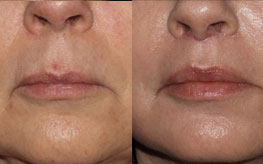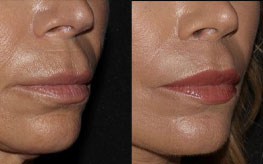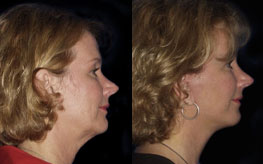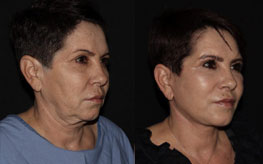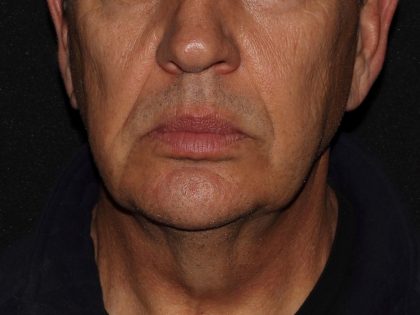Deep Plane Facelift
Conveniently located to serve the areas of San Diego, CA

Dr. Alexander and Dr. Kaplan have a reputation for their San Diego Facelift and meticulous attention to detail, quick healing times, and most important, natural results. As San Diego’s leaders in Facial Rejuvenation, we have performed more facelifts that any other surgeons.
For more information about our face and neck lift procedures, please contact us online or call us at 888-463-9532. We look forward to helping you look your best.
Contents
Before and After Photos
Understanding the San Diego Facelift & Neck Lift Procedure
Facelifts and other facial rejuvenation techniques have been around for over a hundred years. Over this time procedures have become more advanced, offering more and more options to those who want to look younger and more vibrant as they age.
If you are bothered by the signs of aging in your face, a Facelift may be right for you. Also called rhytidectomy (rye-tid-EK-tomy), a facelift is a surgical procedure to improve visible signs of aging in the face and neck, such as:
- Sagging in the cheek (midface)
- Deep creases below the lower eyelids (tear trough)
- Deep creases along the nose extending to the corner of the mouth (nasolabial folds)
- Fat that has fallen or is displaced may create jowls along the jaw line
- Loss of muscle tone in the lower face may create jowls
- Loose skin and excess fatty deposits under the chin and jaw can make even a person of normal weight appear to have a double chin
A facelift doesn’t stop the aging process, but turns back the clock on your face and age. Once healed, the face continues to age at a normal pace. If you look ten years younger after a facelift, it will take about ten years or more for your face to age back to the preoperative condition.
Procedures often performed in conjunction with a Facelift to rejuvenate the face are Brow Lift, to correct a sagging or deeply furrowed brow, Eyelid Lift to rejuvenate aging eyes, and chemical or laser peels to smooth sun-damaged skin.
A San Diego facelift can only be performed surgically; non-surgical rejuvenation treatments, such as peels or fillers, cannot achieve the same results, but may help delay the time at which a facelift becomes appropriate and complement the results of surgery. Thread lifts, also known as Feather Lifts and Contour Lifts, have proven to be very ineffective, because no skin is removed. These procedures have not stood the test of time and have essentially been abandoned.
Before You Decide…
The Consultation
To ensure the most natural looking results, it’s imperative for a surgeon to recommend the procedure which most appropriately matches the patients’ needs and to offer realistic expectations for post-surgery outcomes. When you meet with a surgeon, you should expect a full discussion of the surgically appropriate options for your face, which is uniquely yours.
I have found that most patients are pretty satisfied with how they look, they’re just not happy with the changes of age. Patients don’t want to look different, or changed, just fresher and younger. Most just want to turn back the clock several years. Many patients comment that they look older than they feel, but are wary of cosmetic surgery, especially if they’ve seen poor outcomes in others. We often hear, “I don’t want to look funny, weird, or pulled.”
A good surgeon goes through a series of examinations and observations that are individual and dependent upon your specific situation and goals, but also factor in the surgeon’s expertise, training and experience. If a surgeon specializes in a particular type of facelift procedure, don’t be surprised if it is recommended over other options. Be wary of the “one-size-fits-all” approach.
This is particularly important because as medicine has advanced, patients have more options available. The availability and affordability of options in facelift procedures has made it possible for many more patients to benefit from facial rejuvenation surgery. But it has also made it possible for candidates considering surgery to form some mistaken impressions about procedures.
The success of your facelift depends very much on your complete candidness during your consultation. We will ask you questions about your health, desires and lifestyle. Be prepared to discuss:
- Why you want the surgery, your expectations and desired outcome
- The options available to you for facelift and facial rejuvenation
- Medical conditions, drug allergies and medical treatments
- Use of current medications, vitamins, herbal supplements, alcohol, tobacco and drugs
- Previous surgeries
We may also:
- Examine and measure your face.
- Take digital photographs for computer imaging
- Discuss your options and recommend a course of treatment
- Discuss likely outcomes of a QuickLift™ and any risks or potential complications
- Discuss the anesthesia options available
Other procedures can further enhance the outcome of a QuickLift™. They include:
- facial implants
- Soft tissue augmentation to recontour the facial structure
- Resurfacing techniques to improve the tone and texture of facial skin
- Wrinkle reduction by injection
- Shortening of the upper lip
Questions to Ask
- Were you trained specifically in the field of plastic surgery?
- How many years of plastic surgery training have you had?
- Do you have hospital privileges to perform this procedure?
- Is the office-based surgical facility accredited by a nationally- or state recognized accrediting agency?
- What procedure is recommended for me?
- Am I a good candidate for this procedure?
- How many procedures of this type have you performed?
- Where and how will you perform my procedure?
- What surgical technique is recommended for me?
- How long of a recovery period can I expect, and what kind of help will I need during my recovery?
- What are the risks and complications associated with my procedure?
- How are complications handled?
- What are my options if I am dissatisfied with the cosmetic outcome of my cheek surgery?
- Do you have before-and-after photos I can look at for this procedure and what results are reasonable for me?
Who is a good candidate?
There is no perfect time or age to do a facelift. There is no ideal window of opportunity. Some patients prefer to address problems early, to maintain a younger look. Others prefer to wait until aging is more noticeable, to get more out of the procedure.
A facelift is a highly individualized procedure and you should do it for yourself, not to fulfill someone else’s desires or to try to fit any sort of ideal image. Patients who find themselves looking in the mirror, pulling up their face to see a younger, improved appearance, are usually ready for the procedure.
Because every case is unique, the only way to accurately determine which procedure is best for you is to consult with Dr. Alexander and Dr. Kaplan.
Facelift surgery is a good option for you if:
- You are physically healthy
- You don’t smoke
- You have a positive outlook and realistic expectations in mind for the improvement of your appearance
What does it cost?
Cost is always an important consideration in elective surgery. However, when choosing a plastic surgeon for a facelift, remember that the surgeon’s experience and your comfort are just as important as the final cost.
A quote will be provided to you after your consult with Dr. Alexander and Dr. Kaplan. We offer patient financing plans, so be sure to ask.
Cost may include:
- Surgeon’s fee
- Operating room and supplies
- Prescriptions for medication
- Medical tests
- Anesthesia fees
To learn more about our partner in payment plans, please visit CareCredit.
The Facelift & Neck Lift Procedure
Prior to surgery, we will have you:
- Take certain medications or adjust your current medications
- Avoid taking aspirin, anti-inflammatory drugs and herbal supplements as they can increase bleeding
- Stop smoking well in advance of surgery
During a preoperative appointment, usually 1-2 weeks before surgery, we will:
- Get lab testing or a medical evaluation
- Tell you what to do on the night before and morning of surgery
- Discuss the use of anesthesia during your procedure
- Explain post-operative care and follow-up, and what help you will need after the procedure
Anesthesia
Medications are administered for your comfort during the surgical procedure. The choices include intravenous sedation and general anesthesia. We will recommend the best choice for you.
How We Do It
A facelift typically takes about 2-2.5 hours to perform, depending on several surgical and patient variables. There are four basic steps to any type of facelift, small or large.
Step 1 – Incisions
A traditional facelift incision begins in the hairline at the temples, continues in front of the ear and around the back of the ear and ends in the hair of the scalp. The incision is like a seam in clothing. It is impossible to remove the extra skin without an incision. The more skin that needs to be removed, the longer the length of the incision that needs to be made. Incisions normally heal extremely well and are nearly invisible.
Added step: If the neck is a problem or concern, sometimes a small incision is placed under the chin to remove fat and tighten loose muscle bands.
Step 2 – Undermining, or loosening the skin
Next, the surgeon gently loosens the skin from the underlying muscle (SMAS). The degree of loosening depends on the age of the face and excessiveness of skin. More loosening is required for excessive skin.
Added step: Fat may be sculpted away from the neck and jowls, and fat might be transferred to cheeks or tear troughs.
Step 3 – Tightening the Muscle (SMAS)
The muscle layer can be tightened several ways, including:
- Plication: folding, or pleating the muscle layer with sutures
- Purse string plication: tightening the muscle layer with suture loops
- Undermining: lifting the muscle layer up as a second layer, then removing the excess and closing it with sutures.
Some surgeons skip this step, which is called a “simple facelift” or “skin-only” facelift.
Step 4 – Closing
This is the final tailoring step, where the skin is re-draped over the uplifted contours, excess skin is trimmed away, and the incisions are meticulously closed with removable sutures. We use removable sutures to improve the healing process and minimize scarring. No drains are needed.
Informed Consent
Pain from a facelift is usually minimal. Patients usually experience tightness in the cheeks and neck and some soreness in the jaw for the first few days while eating or opening the mouth. Pain pills are provided but are usually not required after a couple of days. It is uncommon for patients complain of pain.
The decision to have a facelift is extremely personal, and you will have to decide if the benefits will achieve your goals and if the risks are acceptable. In general, the overall risks are very small for Facelift surgery.
We will explain in detail the risks associated with surgery. You will be asked to sign consent forms to ensure that you fully understand the procedure you will undergo including the risks.
Risks include:
- Scars. Facelift scars vary from person to person, but QuickLift™ incisions heal extremely well and are usually very difficult to see
- Hematoma (collection of blood under skin)
- Slow healing
- Bruising and swelling
- Temporary numbness
- Possibility of revisional surgery
It’s very important to ask our surgeons questions about your facelift procedure. It is natural to feel some anxiety, whether it’s excitement for your anticipated new look or a bit of preoperative stress. Don’t be shy about discussing these feelings with us.
Important Terms to Know
Local Anesthesia: the surgical area is numbed up, but the patient is awake. Sometimes a patient will be given an oral medication, like Valium, to help with relaxation.
Sedation (Twilight) Anesthesia: the patient is given an IV, and is made sleepy with medications given through the iv. The level of sedation can be adjusted, from barely sleep to very sleepy. Sometimes sedation is given by the surgeon, and other times it is administered by an Anesthesiologist.
General Anesthesia: the patient is asleep, requiring that the airway be protected, either by a standard breathing tube, or by a laryngeal mask (LMA), an inflatable mask that goes in the back of the throat but doesn’t go down the trachea. Through the airway, an anesthesiologist gives gases to put the patient asleep. Drugs may also be given through the IV.
Tear Trough: A groove below the lower eyelids extending from the nose across the upper cheek.
Nasolabial Fold:The crease that extends from the side of the nose to the corner of the mouth.
Mesolabial Fold (Marionette Lines): The crease that extends from the corner of the mouth down the side of the chin.
Jowls: Soft bulges that sag along the jaw line, usually caused by loss of muscle tone in the lower face.
SMAS: The Superficial Muscular Aponeurotic System, the superficial layer of muscles in the face just below the skin and subcutaneous fat.
Hematoma: An unwanted collection of blood under the skin.
Hypertrophic Scar: A hyperactive, usually temporary scarring process that makes a scar raised and red, sometimes called a “baby keloid.” This is more common in patients with pigmented complexion and more common on the chest, trunk, and shoulders, and it’s very uncommon on the face and neck.
Recovery
Recovery times vary from patient to patient. In general, the “bigger” the procedure, the longer the recovery time, and the converse is also true. However, within each group of patients, there are individual differences.
Traditional facelift recovery takes an average of 8-20 days. Bear in mind, however, that these are averages. Some individuals may heal much more quickly, while others may take longer to fully recover. A patient who tends to have more bruising and swelling than normal will take longer to heal.
The Specifics
After a facelift, most patients should allow two weeks before returning to work and other normal day-to-day activities and about three weeks before working out.
Following your doctor’s instructions regarding medications and other post-operative measures is key to a quick recovery. Herbal medications are available to reduce swelling, bruising, and to speed your recovery.
It is important that the surgical incisions are not subjected to excessive force, abrasion, or motion during the time of healing. Avoid wearing any clothing that must go over your head. We will give you specific instructions on how to care for yourself.
When your procedure is completed, a bandage could gently be placed around your face to minimize swelling and bruising.
It is normal for the face to feel tight. If one side is significantly more painful or swollen than the other side you should call the office. If you experience shortness of breath, chest pains, or unusual heartbeats, call the office immediately. Should any of these complications occur, you might require hospitalization and additional treatment.
You will be given specific instructions that include:
- how to care for the surgical site
- medications to apply or take orally to aid healing and reduce the potential for infection
- specific concerns to look for at the surgical site or in overall health
- when to return to the office
We will see you the day after surgery, then on the 4th or 5th day to remove some sutures, and again on the 7th day to remove the remainder of the sutures. At one week you can resume normal activities. At two weeks you can begin light exercise, and at three weeks there are no restrictions.
Results
It’s natural to feel impatient about seeing the “new” you, but you’ll need to be patient as your face heals from the surgery. The visible improvements appear as swelling and bruising subside. It may take several months for swelling to fully dissipate and up to 6 months for incision lines to mature. Once healed, the incision lines from a facelift are well concealed within the hairline and in the natural contours of the face and ear.
Because I have worked with so many patients, I can look at someone relatively early in their recovery and say, “You look great,” even though that patient can only see how they look that day — not how they will look a few weeks later. Your final result should not only restore a more youthful and rested appearance, but also help you feel more confident about yourself.
After a few months pass it is not uncommon for patients to become so used to their new appearances that they barely notice the change. This is similar to when you get a new haircut and can’t help but notice your reflection every time you pass a mirror. After a few months, your self-image resets, and you may not recall how drastic the change is until you happen upon an old photograph.
The same phenomenon occurs with facial rejuvenation, and is one of the main reasons we take “before” pictures. Patients quickly forget how they used to look! For the first few months after a procedure, the change is dramatic, and the mind is constantly noticing and comparing the younger look to the older face. After a few months, the mind has reset the new look as the new self-image. Once this becomes the new norm, it is easy to look in the mirror and still see some signs of aging. However, when the patient looks at old pictures, they are often surprised they have forgotten what they used to look like, and how much they have improved.
If our patients tell us they’re receiving a lot of compliments, but nobody knows they’ve had surgery, we feel like we’ve achieved our goal. And one of the ways we do this is by keeping things very simple and conservative. Some surgeons overplay their artistic ability and make recommendations that really change a person’s face and make them look quite a bit different than they used to. Our goal is to not change a person’s face, just to give them a better version of what they already have.
In general our patients are very pleased with their results. The practice of medicine and surgery is not an exact science. Although good results are expected, there is no guarantee. In some situations, it may not be possible to achieve optimal results with a single surgical procedure. Another surgery may be necessary.

